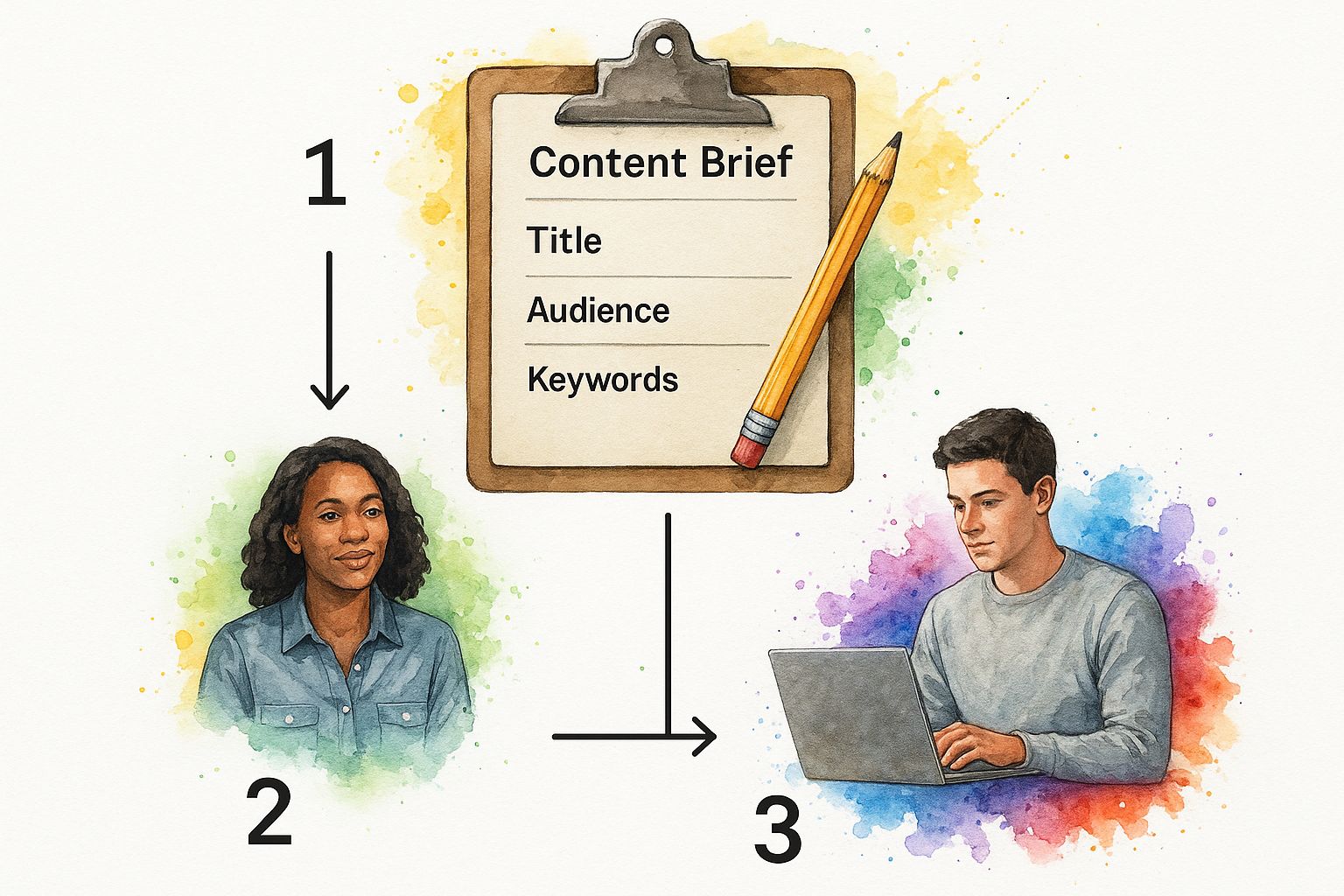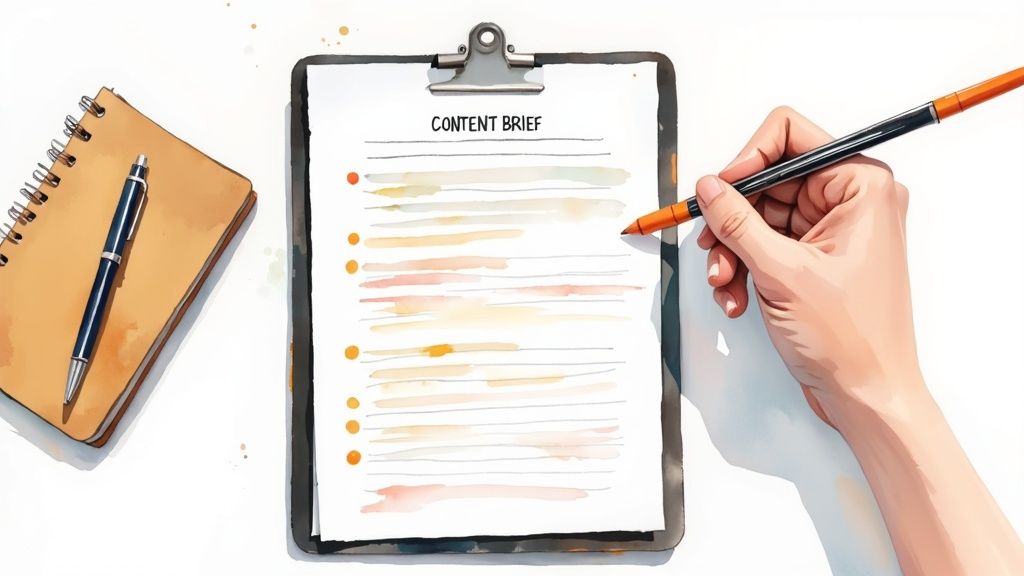A content brief template is a structured document that outlines the goals, requirements, and creative direction for a piece of content. Think of it as the single source of truth for your writers, editors, and strategists. It gets everyone on the same page before a single word gets written.
This simple tool is your best defense against costly rework and the easiest way to make sure every article supports your business goals.
Why Your Content Workflow Needs a Strong Brief
Let’s be honest: creating great content at scale is tough. Without a clear plan, projects can easily spin out of control. I’ve seen it happen more times than I can count.
A writer turns in a draft that completely misses the audience's tone. A crucial SEO opportunity gets overlooked. An editor has to request a full rewrite because the core message was lost in translation. This isn't just frustrating—it's expensive.
A solid content brief template takes this messy, reactive process and makes it strategic. It isn't a list of rigid rules. It's a blueprint for success.
Key Elements of a High-Impact Content Brief
To get a clearer picture, let's break down what actually goes into a brief that works. These are the core components I've found to be non-negotiable for aligning teams and producing content that hits the mark every time.
| Component | Its Strategic Purpose |
|---|---|
| Primary/Secondary Keywords | Aligns the content with specific search queries and user intent. |
| Target Audience & Persona | Defines who the content is for, guiding tone, language, and depth. |
| Core Message/Angle | The main takeaway or unique perspective the content must convey. |
| Tone of Voice | Ensures the writing style matches the brand's personality (e.g., formal, witty). |
| Competitor & SERP Analysis | Provides context on what's already ranking and identifies content gaps. |
| Outline & Key Sections | Creates a logical structure for the writer to follow, ensuring all key points are covered. |
| Internal Linking Targets | Identifies opportunities to link to other relevant pages on your site. |
Having these elements defined upfront is what separates a smooth, efficient workflow from a chaotic one.
Bridging the Gaps Between Teams
Imagine an SEO strategist identifies a high-value keyword but doesn't clearly communicate the user's intent behind the search. The writer, left to guess, produces a beautifully written but strategically useless article. The editor, focused on brand voice, is then stuck requesting major revisions.
This cycle of miscommunication torches time, budget, and creative energy.
A well-crafted brief prevents this entire mess by creating a shared understanding from the very beginning. It makes sure that: * Writers know the audience, the tone, and the strategic purpose. * SEO Strategists see their keyword and intent research properly translated into the final article. * Editors have a clear benchmark to measure quality and consistency against.
Adapting to an Evolving Content Scene
This need for structure has never been more critical. As content gets deeper and more comprehensive, the margin for error gets smaller.
For instance, the average blog post length shot up to around 1,427 words by 2025, a jump of over 70% in just a decade. This complexity demands a more buttoned-up approach to keep every piece focused and clear.
A content brief is the most important—and most underrated—tool for scaling content quality. It’s the difference between consistently hitting your goals and constantly wondering why your content isn't performing.
Ultimately, using a content brief template is about building a system for quality that can scale. It empowers your team to work smarter, cuts down on friction, and guarantees every piece of content serves a real purpose.
For more insights on building a strong content foundation, check out the other guides on our blog.
Building Your Master Content Brief Framework
Forget those generic, one-size-fits-all documents. They just don't work. If you really want to streamline your content process and ensure every piece hits the mark, you need a master content brief template. Think of it as a reusable blueprint that becomes the strategic core for every article, guide, or landing page you produce. This isn't just about making a list of fields to fill out; it’s about embedding the strategic "why" into every single section.
The idea is to build a framework that’s detailed enough to give writers crystal-clear direction but also flexible enough to adapt to different types of content. It’s like building the chassis of a car. The core structure is always the same, but you can swap out the engine or change the paint job depending on where you’re headed.
I’ve found that the best briefs have a few non-negotiable components that all work together. This infographic breaks down what those core elements look like.

As you can see, things like audience definition, keyword strategy, and the article outline all come together to create a single source of truth for your content team. No more guessing games.
Defining Your Target Audience
This is where I see most briefs fall flat. A vague description like "small business owners" is completely useless. A writer can't connect with a generic label, and if they can't visualize the reader, the content will feel disconnected. Your template needs a dedicated section for a detailed audience persona that actually brings the reader to life.
For instance, instead of that generic label, give your writer something they can sink their teeth into:
- Persona Name: "Startup Sarah"
- Role: Founder of a pre-seed SaaS company with 1-5 employees.
- Knowledge Level: She's an expert in her own product domain but a total beginner when it comes to digital marketing. She’s heard of SEO but has no idea where to even begin.
- Pain Points: She feels drowned in marketing advice, has a tiny budget, and desperately needs actionable, low-cost strategies to get some initial traction.
- Goals: Her immediate goal is to find her first 100 customers. She wants to understand the absolute basics of content marketing to start driving organic traffic.
See the difference? This level of detail immediately gives the writer a real person to write for. It instantly influences the tone, the complexity of the language, and the kinds of examples that will resonate.
Setting Clear Content Objectives
Every single piece of content needs a job. And no, "ranking on Google" is not a job—it's an outcome. Your brief must spell out the strategic purpose of the content. What, specifically, do you want the reader to do after they've finished reading?
A great content brief doesn't just tell a writer what to create; it tells them why it matters. When writers understand the business goal, they become strategic partners, not just wordsmiths.
Your template should have space for objectives like these: * Primary Objective: Drive sign-ups for our "SEO for Beginners" webinar. * Secondary Objective: Build topical authority around the concept of "early-stage startup marketing." * User Goal: Help the reader build their very first keyword list in under 30 minutes.
This kind of clarity makes sure the call-to-action (CTA) and the entire message of the piece are perfectly dialed in to meet the business goal.
Articulating Keyword Strategy and Structure
This part of the brief needs to go way beyond just listing a primary keyword. A truly effective content brief template maps out the entire keyword ecosystem and provides a required structure. This is how you stop writers from guessing and bake SEO into the content from the very beginning.
I've found a simple table works wonders here:
| Keyword Type | Example | Placement Guidance |
|---|---|---|
| Primary Keyword | content brief template | Must appear in the H1, first 100 words, and at least one H2. |
| Secondary Keywords | content brief example, seo content brief | Use naturally in subheadings and body copy where it makes sense. |
| Semantic/LSI Terms | writer guidelines, content outline, SERP analysis | Weave these concepts throughout the text to build topical depth. |
This gives the writer a clear roadmap. But you can't stop there. The next section in your brief must be the Required Outline. This is non-negotiable. It’s the key to maintaining structural integrity and ensuring all the critical talking points get covered.
I usually provide the exact H1 and all the H2 headings I expect to see. For longer, more complex articles, I’ll even suggest key H3s to guide them.
This pre-defined structure acts as a set of guardrails. It guarantees the article flows logically and comprehensively covers the topic in a way that aligns with what your SERP analysis has already told you is working. It provides a solid skeleton, freeing up the writer to focus their energy on fleshing it out with their unique expertise and creativity.
Weaving SEO and Audience Intent into Every Brief

A great content brief does more than just list keywords. It needs to speak to search engines and the actual person reading the content. This means moving past a simple checklist and into the more nuanced art of decoding search intent.
This is where you turn a list of instructions into real, actionable intelligence. It's what gives your writer a serious competitive edge.
The first move? A manual check of the search engine results page (SERP). Before you even think about adding keywords to your content brief template, go to Google and search for your primary term.
What’s ranking on page one? Are they "how-to" guides? Listicles? Short blog posts that give a direct answer? Maybe they're all product comparison pages. The SERP is your ultimate cheat sheet. It tells you exactly what format Google already thinks is the best fit for that query.
If the top-ranking results are all long, detailed guides, then writing a short, fluffy piece is just a waste of everyone's time. Your brief has to steer the writer toward the format that’s already proven to work.
Identifying Crucial Topics and Entities
Beyond just the format, you need to pinpoint the specific topics and "entities" Google expects to see. Think of these as the related concepts, people, products, or places that signal you know your stuff. A quick look at the SERP will show you these patterns.
Let's say you're targeting "how to start a podcast." A quick scan of the top articles will probably show that every single one talks about:
- Microphone types (like condenser vs. dynamic)
- Recording software (Audacity, Riverside, etc.)
- Podcast hosting platforms
- Monetization strategies
These aren't just a bunch of related keywords. They're the core building blocks of a complete answer. Your brief absolutely must list these "must-have" subtopics. This ensures your writer covers the topic with enough depth to actually compete.
The real goal isn't just to rank for a single keyword. It's to build a resource so thorough and genuinely helpful that it becomes the go-to answer for that topic. That’s how you earn trust from both readers and search engines.
Arming Your Team with Competitive Insights
Your brief should also pack a punch with specific intelligence from your competitor analysis. I don't just mean listing their URLs. I mean giving your writer actionable takeaways. To make sure your content doesn't just inform but also ranks, a solid grasp of blog search engine optimization is non-negotiable.
Here’s what that kind of analysis should look like inside your brief:
- Competitor A: They're ranking #1, but their section on "podcast editing" is super weak. We can win by creating a much more detailed breakdown here, complete with tool recommendations.
- Competitor B: They use a great case study, but it lacks actionable steps. We should include a downloadable checklist for our readers.
- Internal Link Opportunity: This new post needs to link to our existing "Guide to Audio Editing." This passes authority and gives the reader a better path through our site.
This level of detail empowers your writer. They’re no longer just "creating content." They're executing a precise strategy designed to pick apart the weaknesses in the current top results. It's the same mindset behind optimizing high-converting landing pages, where every single element is chosen to hit a specific goal.
This focused approach is what separates content that just competes from content that actually wins.
A perfect content brief is a beautiful thing. But if it just collects dust in a Google Drive folder, it's completely useless. The real magic happens when you weave it into your team's day-to-day, turning it from a static document into a living, breathing tool for creating awesome content.
So, how do you make that happen? It all starts with the kickoff call.
Please, don't just email the brief to your writer and hope for the best. Schedule a quick, 15-minute call to walk through it together. This simple step transforms a list of instructions into a real strategic conversation. It’s your chance to get across all the subtle stuff—the "why" behind your keyword choice or the specific pain point you really need the piece to hit.
For the writer, this is their moment to ask questions, get clarity, and actually get excited about the project. A few minutes invested upfront can save you from hours of frustrating and expensive rewrites down the line. Trust me on this.
Adapting Your Template for Different Formats
Your main brief is a solid foundation, but you can't treat all content the same. The details a writer needs for a 3,000-word blog post are worlds apart from what's required for a high-converting landing page or a punchy social media update.
This is where you need to get flexible. Create a few different versions of your master content brief template, each tailored for a specific job.
- Blog Post Brief: This is the big one. It should have all the bells and whistles, like a detailed SERP analysis, a complete outline, and specific internal linking opportunities.
- Landing Page Brief: Here, the focus shifts. You'll want to go deep on the target audience, the single, unmissable call-to-action (CTA), and the core value proposition. SEO is important, but conversion-focused copy is king.
- Social Media Brief: Keep it short and sweet. The priority here is the core message, the emotion you want to evoke, any visual direction, and specific hashtags or accounts to mention.
By tailoring the brief, you're giving your team exactly what they need to succeed, without burying them in information that doesn't matter for the task at hand.
Establishing a Collaborative Feedback Loop
The brief’s job isn’t over once the first draft lands in your inbox. It should be the North Star for your entire feedback process.
When you're suggesting edits, always tie your comments back to the brief.
Instead of a vague comment like, "The tone feels a little off," try something more specific: "Let's look back at the 'Startup Sarah' persona in the brief. This section feels a bit too corporate for her." This approach makes feedback feel objective and helpful, not personal or critical. It keeps everyone on the same page, working from the same strategic map.
Treat the content brief like a partnership agreement. It’s there to empower creativity by providing clear guardrails, not to build a cage. This mindset protects your marketing goals while freeing up your writers to produce their absolute best work.
Of course, once you've used a solid brief to create a fantastic piece of content, the work isn't done. Its ultimate success will depend on having effective content promotion strategies in place to get it in front of the right eyeballs. The brief ensures the asset is right; promotion ensures that asset actually drives results.
Common Briefing Mistakes That Kill Creativity
Even the most well-intentioned content brief can backfire. I’ve seen it happen countless times. Instead of being a helpful guide, it turns into a creative straitjacket that chokes the life out of a project before it even starts.
The goal is to provide direction, not dictation. A great content brief template empowers your writers. A flawed one does the exact opposite.

One of the biggest culprits? Information overload. Some briefs are so jam-packed with competitor links, SEO keywords, and rambling notes that the writer is completely paralyzed. They end up spending more time trying to tick every single box than they do actually writing.
Being way too prescriptive is another major problem. When a brief dictates every talking point and sentence structure, it leaves zero room for the writer's own expertise to shine through. You hired them for a reason, right? Boxing them in like that completely undermines their value and almost guarantees you’ll get robotic, uninspired copy in return.
The Problem of Vague Guidance
On the other side of the coin, a brief that’s too vague is just as destructive.
Sending over a request like "write about topic X" with no context on the audience, the core angle, or the tone of voice is a recipe for disaster. The writer is left to guess what you want. This almost always leads to a first draft that completely misses the mark, forcing you into a painful, time-sucking revision cycle.
This is especially true when it comes to critical elements like your brand's voice. A simple instruction like "be professional" is useless. What does that actually mean? Are we talking academic and formal, or expert and approachable?
A brief should be a strategic map, not a coloring book with every section already filled in. It provides the destination and key landmarks but lets the writer drive the car.
Let's look at a common before-and-after scenario I see all the time:
- Before (Vague): "Write a post about social media tools. The target audience is small businesses."
- After (Clear): "Create a comparison guide of 3 top social media scheduling tools for bootstrapped founders. Focus on affordability and ease of use, using a helpful, mentor-like tone."
See the difference? The second example gives the writer clear guardrails. It sets them up for success without killing their ability to weave a compelling story. If you need to find creative talent who can take that kind of strategic direction and run with it, a professional services directory is a great place to find skilled writers and agencies.
Ultimately, a winning brief is all about striking a delicate balance. It needs to be specific enough to keep everyone aligned on the strategy but open enough to invite creativity and expertise. This approach builds a real partnership with your writers and leads to content that actually performs.
Frequently Asked Questions About Content Briefs
Even with the best template in hand, putting a new process into action always brings up a few questions. Let's tackle some of the most common ones we hear when teams start using content briefs.
How Long Should a Good Content Brief Be?
There's no magic number, but a great content brief usually lands somewhere between 1-2 pages, or about 500-800 words.
The real goal isn't hitting a specific word count. It's about giving your writer a clear map without writing the article for them. You need to provide enough strategic direction—the goals, the audience, the core keywords, the structure—to set them up for success. If it gets so long and detailed that it stifles their creativity, you've gone too far.
Think of it as a strategic map, not a pre-written article. When in doubt, always choose clarity and actionable guidance over sheer length.
Can I Use AI to Create a Content Brief?
Absolutely. In fact, you probably should. AI tools are brilliant for knocking out the early-stage research and saving a ton of time.
Here's how we see it fitting in:
- Quick SERP Analysis: Use AI to pull apart what top-ranking competitors are doing. What are their heading structures? What common themes pop up again and again?
- Keyword Brainstorming: Generate lists of secondary and LSI keywords to give your article the topical depth it needs to rank.
- Finding Common Questions: Quickly identify the questions people are actually typing into Google about your topic. This is gold for an FAQ section.
But—and this is a big but—AI can't do it all. The final brief needs a human touch. A content strategist has to layer in the nuance that AI misses, like your unique brand voice, smart internal linking opportunities, and the company perspective that makes your content genuinely different from everything else out there.
How Do You Get Writers to Actually Follow the Brief?
This is the million-dollar question, isn't it? It almost always comes down to two things: collaboration and clarity.
First off, make the brief itself easy to digest. No one wants to squint at a wall of text. Use headings, bullet points, and bold text to make key instructions pop.
Next, treat the brief as a conversation starter, not a set of commandments. We always try to have a quick kickoff call to walk through the document and answer any questions. Getting that buy-in from the writer right at the start makes a huge difference.
And maybe most importantly, explain the why. When a writer understands the strategic thinking behind the keyword choices or gets a real feel for the target audience's pain points, the brief stops being a list of rules. It becomes a tool that helps them do their best work.
Ready to stop the endless cycle of revisions and start producing content that hits the mark every time? rebelgrowth provides AI-powered tools and a complete marketing workflow to turn your strategic briefs into high-ranking articles. Simplify your content creation process and see real results. Explore rebelgrowth today!
